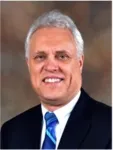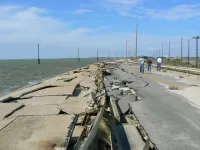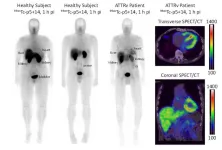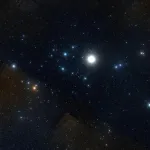(Press-News.org) Toronto, Ontario—Jean-Luc C. Urbain, MD, PhD, FASNC, professor of Radiology/Nuclear Medicine and Medicine, has been named president-elect of the Society of Nuclear Medicine and Molecular Imaging (SNMMI). SNMMI introduced a new slate of officers during its 2024 Annual Meeting, held June 8-11 in Toronto.
“As SNMMI president-elect, I plan to focus on bringing and integrating radiopharmaceutical theranostics into the clinic to benefit as many patients as possible. This will require an emphasis on research, government approvals, education, training, quality and safety of practice issues, and reimbursement concerns,” stated Urbain. “I look forward to working with all SNMMI members, stakeholders, and patients ‘communities to achieve these goals.”
Urbain will also continue to bolster SNMMI’s outreach to the global nuclear medicine community by focusing on underrepresented professionals and communities, facilitating their participation in SNMMI activities and underserved patients’ communities. Promoting the SNMMI brand at the national and international level will be another top priority for Urbain as he works to increase the society’s visibility, membership, and financial support.
Urbain received his medical degree from the University of Louvain Medical School in Brussels, Belgium, where he also completed residencies in Medicine and Medical Imaging/Nuclear Medicine. Urbain was a fellow at Temple University in Philadelphia, Pennsylvania and earned a doctoral degree from the Temple University Fels Institute for Cancer Research and Molecular Biology. He is recognized as a Health Care Executive Management diplomate (Cleveland Clinic Foundation, Cleveland, Ohio), an Academic Management diplomate (Harvard Macy, Cambridge, Massachusetts, and Ivey Business School, London, Ontario, Canada), and an American College of Physicians Executive diplomate, Certified Physician Executive (Tampa, Florida).
Over his 35-plus year career, Urbain has held many academic appointments at the Catholic University of Louvain, Temple University, University of Western Ontario in London, Ontario, and most recently as Nuclear Radiology Fellowship Program Director at Wake Forest University in Winston-Salem, North Carolina. His hospital appointments include positions at Catholic University of Louvain; CHGH University Affiliated Hospital in Hornu, Belgium; Temple University Hospital; Fox Chase Cancer Center in Philadelphia, Pennsylvania; the Cleveland Clinic Foundation; St. Joseph’s Health Care, London Health Sciences Centre & University of Western Ontario; the VA Medical Center - Milton Hershey Penn State Medical College in Lebanon, Pennsylvania; Wake Forest Baptist Medical Center; Roswell Park Cancer Center and Brantford General, Pembroke Regional, and Stratford General Hospitals in Ontario, where he currently serves as a staff physician in addition to his consulting activities to academic centers.
Within SNMMI Urbain has served in multiple roles in addition to his most recent post as vice president-elect. He was a member of the Nominating Committee and served as chair of the Global Initiative Committee. Urbain is currently a member of the Therapy Strategic Plan Task Force, Quality and Patient Safety Committee, Community Based Committee, Center of Excellence Task Force and Therapy Center of Excellence Task Force; he also serves as a Radiopharmaceuticals Center of Excellence reviewer. He was a member of the Eastern Great Lakes Chapter of SNMMI and served as its president from 2010-2011.
Additionally, Urbain is an active consultant for and participant in the Lancet Oncology Commission Report on Theranostics and International Atomic Energy Agency. In the past, he served as president of the World Federation of Nuclear Medicine & Biology, vice president of the Canadian Neuro Endocrine Tumors Society, co-chair of the Waiting Time Alliance, president of the Canadian Association of Nuclear Medicine, and secretary of the Belgium Society of Nuclear Medicine.
Urbain is a member of the Radiological Society of North America, American Society of Clinical Oncology, American Society of Nuclear Cardiology and European Association of Nuclear Medicine. He received the Homi Jehangir Bhabba Award Honorary Degree in 2007 from the Society of Nuclear Medicine, India, and the GE Radiant Fund from the Canadian Association of Nuclear Medicine in 2006. Urbain has published about 100 journal articles and 15 book chapters and has given more than a thousand invited speaker presentations. He is co-editor of the international outreach ePatient magazine.
Other SNMMI officers elected for 2024-25 are Cathy Sue Cutler, PhD, FSNMMI, Upton, New York, as president and, Heather Jacene, MD, Boston, Massachusetts, as president-elect. SNMMI Technologist Section officers for 2024-25 are Julie Dawn Bolin, MS, CNMT, Phoenix, Arizona, as president and Cybil Nielsen, MBA, CNMT, FSNMMI-TS, Long Beach, Mississippi, as president-elect.
About the Society of Nuclear Medicine and Molecular Imaging
The Society of Nuclear Medicine and Molecular Imaging (SNMMI) is an international scientific and medical organization dedicated to advancing nuclear medicine and molecular imaging—vital elements of precision medicine that allow diagnosis and treatment to be tailored to individual patients in order to achieve the best possible outcomes.
SNMMI’s members set the standard for molecular imaging and nuclear medicine practice by creating guidelines, sharing information through journals and meetings and leading advocacy on key issues that affect molecular imaging and therapy research and practice. For more information, visit www.snmmi.org.
END
SNMMI elects Jean-Luc C. Urbain, MD, Ph.D., FASNC, as President-Elect at 2024 Annual Meeting
2024-06-10
ELSE PRESS RELEASES FROM THIS DATE:
UNC-Chapel Hill researchers create skin-inspired sensory robots to provide medical treatment
2024-06-10
University of North Carolina at Chapel Hill scientists have created innovative soft robots equipped with electronic skins and artificial muscles, allowing them to sense their surroundings and adapt their movements in real-time, according to the paper, “Skin-Inspired, Sensory Robots for Electronic Implants,” in Nature Communications.
In their research, funded by the National Science Foundation and the National Institutes of Health, the robots are designed to mimic the way muscles and skin work together in animals, making them more effective and safer to use inside the body. The e-skin integrates various sensing materials, such as silver nanowires ...
Researchers use 3D visualization to predict, prevent hurricane damage
2024-06-10
Beginning annually on June 1, hurricane season poses a major threat to Texas coastal communities, causing both physical and financial damage to the areas they hit. This damage can be staggering; when Hurricane Harvey hit in 2017, it cost Galveston $132.73 billion in damages. Texas A&M University researchers have collaborated to understand the impacts of storm surge floods before they occur to potentially reduce the level of damage. Their study was published in “Urban Informatics.”
The researchers have implemented 3D visualization technology to identify the potential outcomes of hurricane flooding ...
Kepplinger, Vidyashankar to receive funding for conference
2024-06-10
David Kepplinger, Assistant Professor, Statistics, and Anand Vidyashankar, Professor, Statistics, are set to receive funding from the National Science Foundation for: “Conference: Building a robust community: Joint International Conference on Robust Statistics and Conference on Data Science, Statistics, and Data Science.”
Kepplinger and Vidyashankar will receive $20,993 from NSF for this award. Funding will begin in July 2024 and will end in late June 2025.
The funding will support 15–20 students and early-career researchers to participate in the joint International Conference on Robust Statistics (ICORS) and the Conference ...
Novel radiotracer produces high quality images of “Alzheimer’s disease of the heart”
2024-06-10
Toronto, Ontario—A newly developed radiotracer can generate high quality and readily interpretable images of cardiac amyloidosis, a condition referred to as the “Alzheimer’s disease of the heart.” As the first amyloid-specific and pan-amyloid binding radiotracer designed for planar and SPECT/CT imaging, 99mTc-p5+14 could play an important role in early detection and treatment of cardiac amyloidosis. This research was presented at the 2024 Society of Nuclear Medicine and Molecular Imaging Annual Meeting.
Systemic amyloidosis is an incurable disease in which abnormal amounts of ...
New AI tool accurately detects six different cancer types on whole-body PET/CT scans
2024-06-10
Toronto, Ontario—A novel AI approach can accurately detect six different types of cancer on whole-body PET/CT scans, according to research presented at the 2024 Society of Nuclear Medicine and Molecular Imaging Annual Meeting. By automatically quantifying tumor burden, the new tool can be useful for assessing patient risk, predicting treatment response, and estimating survival.
“Automatic detection and characterization of cancer are important clinical needs to enable early treatment,” said Kevin H. ...
Galactic bloodlines: Many nearby star clusters originate from only three "families"
2024-06-10
An international team of astronomers led by the University of Vienna has deciphered the formation history of young star clusters, some of which we can see with the naked eye at night. The team, led by Cameren Swiggum and João Alves from the University of Vienna and Robert Benjamin from the University of Wisconsin-Whitewater, reports that most nearby young star clusters belong to only three families, which originate from very massive star-forming regions. This research also provides new insights into the effects of supernovae (violent explosions at the end of the life ...
New City of Hope study shows liver surgery to remove cancer can now be a safe, outpatient procedure
2024-06-10
LOS ANGELES — A new study guided by a renowned surgeon at City of Hope®, one of the largest cancer research and treatment organizations in the United States, demonstrates that robotic liver surgery can be a safe, outpatient procedure. In fact, 8% of the patients sampled in the analysis were discharged to go home on the same day.
“We have made so much progress in liver cancer. We can now deliver more cures and use less invasive treatment options. This study is proof that for the right patients and with the right tools — meaning robotic surgery — we can get people through a liver operation quicker and toward recovery and normal ...
For type 1 diabetes distress, focus first on managing emotions
2024-06-10
FOR IMMEDIATE RELEASE
Media Contact: Jess Berthold (628) 399-0432
Jess.Berthold@ucsf.edu
Subscribe to UCSF News
For Type 1 Diabetes Distress, Focus First on Managing Emotions
Virtual, emotion-centered program cuts distress in half after one year, while also improving patients’ glucose control.
The most effective way to reduce the distress that comes with having diabetes – and improve glucose control – is to focus on managing the emotional strain of living with the condition, a new study of adults that was led by researchers at UC San Francisco has found.
Diabetes distress, or DD, refers to ...
Webb telescope reveals asteroid collision in neighboring star system
2024-06-10
Astronomers have captured what appears to be a snapshot of a massive collision of giant asteroids in Beta Pictoris, a neighboring star system known for its early age and tumultuous planet-forming activity.
The observations spotlight the volatile processes that shape star systems like our own, offering a unique glimpse into the primordial stages of planetary formation.
“Beta Pictoris is at an age when planet formation in the terrestrial planet zone is still ongoing through giant asteroid collisions, so what we could be seeing here is basically how rocky planets and other bodies are forming in real time,” said Christine Chen, a Johns Hopkins University astronomer ...
When is genome sequencing advisable?
2024-06-10
Genetic mutations in human DNA can prevent proteins that perform important functions in the body from being formed correctly. This can lead to serious disorders that cause disease or even disability. Many of these diseases are already known and can be attributed to specific genes. To diagnose them, clinicians use a standard procedure known as exome sequencing. This involves analysing those segments of human DNA that are directly responsible for the correct formation of proteins. This coding part, the exome, makes up only around ...






